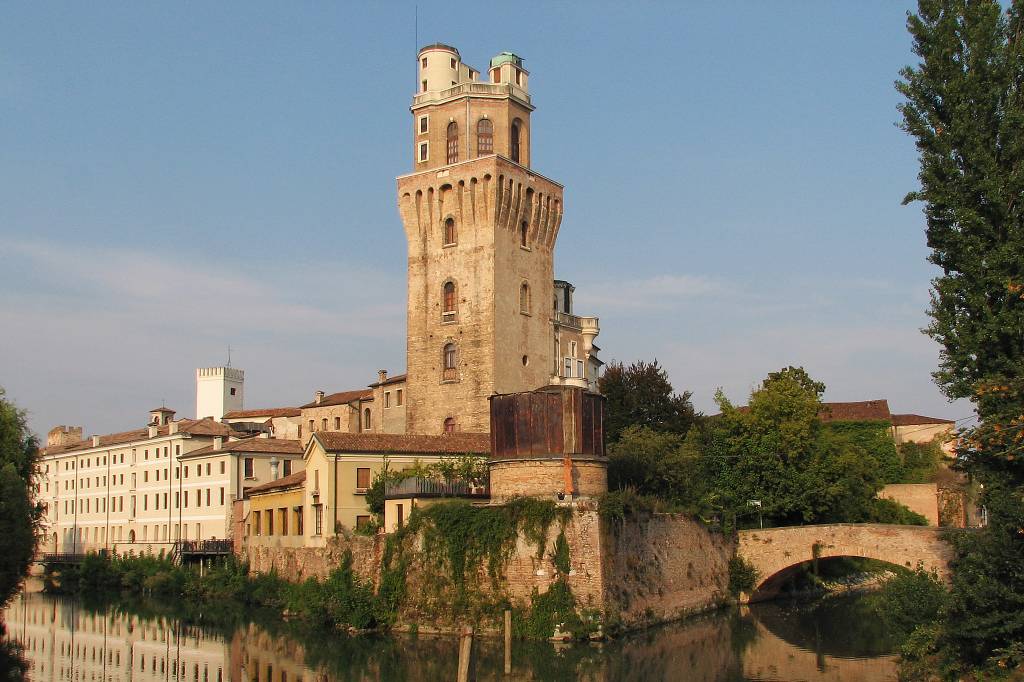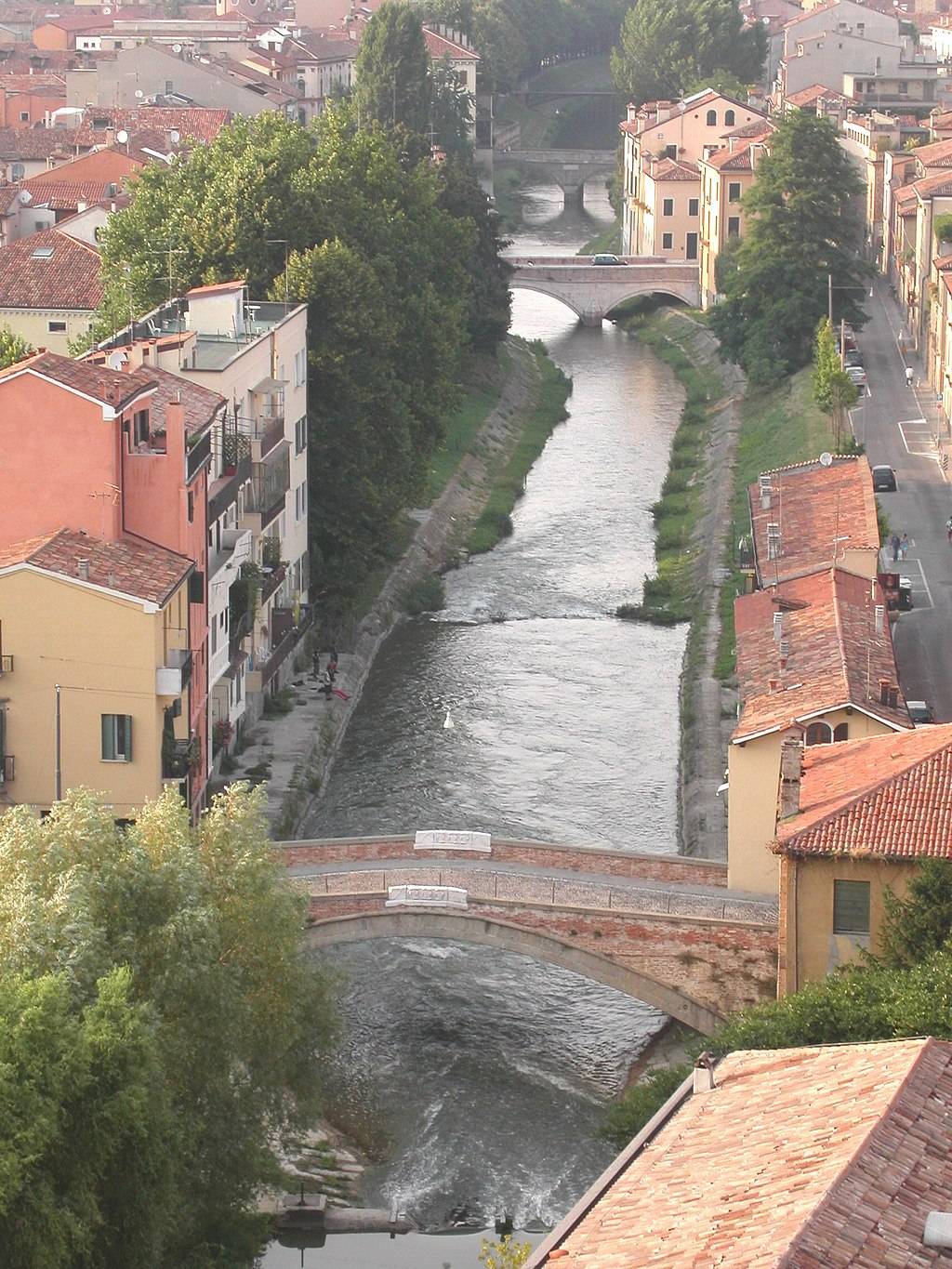La Specola, the astronomical observatory
La Specola has been the astronomical observatory of Padua since 1765, built in the tower of Castelvecchio, the ancient castle of the city and the pride of medieval Padua.

The Carrara Castle, also known as Castelvecchio, is a fortification of early medieval origin placed just inside the city walls, on the bifurcation of the Bacchiglione, the river that flows in Padua and feeds its internal canals. Its high tower Specola is one of the most representative symbols of the city and its history, recalling multiple aspects of the various historical periods experienced by the city, from oppression to scientific freedom.
The Carrara Castle
The history of what will later become the Carrara Castle begins in the age of Charlemagne when a stone wall and an embankment were built in a place of important transit ever since Roman times. Here, after the invasion of the Hungarians in 899, a first defence tower was erected, the Torlonga. Then, in 1242, Ezzelino III da Romano, who became lord of Padua, had built on the site close to the municipal walls a fortified complex with two towers. The largest of which incorporated the Torlonga and it was the place where the tyrant kept locked up and tortured his prisoners.
After the end of Ezzelino's reign, the fortifications were abandoned until the lordship of the Carraresi had the castle rebuilt. Francesco I da Carrara entrusted the work to Nicolò della Bellanda, a significant figure in the military architecture of the time. The new castle was connected to the Carrara Palace, the residential complex the family had built within the city walls, by “the ferry to the walls”, an elevated passage that connected the centres of political and military power. But the castle wasn’t just a simple fortress; it also served as a place of reception for famous people. It was described at the time as one of the “most beautiful castles from a strategic, military and architectural point of view”. It comprised defensive walls, two drawbridges, a parade ground, loggias, and a frescoed armoury. The whole castle was decorated inside and out, and the two towers were red and white checkered painted, as can be seen in the fresco representing the view of the city made by Giusto de 'Menabuoi in 1382 in the chapel of Blessed Luca Belludi of the Basilica of Saint Anthony.
When Padua fell under Venetian rule in 1405, the long decline of the Castle began. The defensive walls built by the Carraresi were replaced by the sixteenth century's Renaissance Walls, and due to the extended period of peace under the Venetian rule, the castle and the Torlonga lost their military function and fell into neglect. In fact, in the eighteenth century, the ancient fortress, largely dilapidated, was called “the old castle” or Castelvecchio and for some time had been used as a warehouse for grain, straw, hay, a warehouse for weapons and ammunition, and then transformed into a prison, a function that it maintained long after the Second World War.
Numerous interventions divided the complex into various parts with different functions. But the most significant transformations took place at the end of the eighteenth century when to old Torlonga tower was transformed into an Astronomical Observatory.
La Specola
In 1761 the Senate of the Republic of Venice issued a decree with which it established an astronomical observatory, a Specola, for the University of Padua. The project was entrusted to abbot Giuseppe Toaldo, who proposed to use the high tower of the Castelvecchio for its large and solid walls and its location within the city, ideal for astronomical observation.
The Tower significantly changed its appearance at the end of the works carried out on a project by Domenico Cerato, which planned the creation of two separate observatories, each suitable for a specific function. The lower observatory was built at 16 meters above the ground, where a meridian line was built, fundamental to determine the exact moment of the local noon, and a large wall-mounted quadrant was installed that was used to observe the celestial meridian, a crucial point for the study of the motion of the stars. A terrace was built above the Meridian Room for meteorological studies. The upper Observatory was created at 35 meters high in the area of the tower battlements, where an octagonal room with tall windows was set up to observe the celestial vault from every angle.
In 1786 the new observatory received one of its first visitors, Goethe, who described the experience in his Italian Journey.
The observatory was equipped with various instruments for measuring celestial coordinates, dials, refracting binoculars and pendulum clocks. In 1773, Toaldo obtained permission to install a lightning rod, the invention made by Benjamin Franklin in 1750, the first one in the Republic of Venice.
Subsequently, the Specola underwent various modernisations of the instrumentation and structure, such as adding a third dome in the nineteenth century and constructing a pavilion on the adjacent bastion to house a Merz refractor telescope.
One of the myths regarding the astronomical tower is that the Specola tower is Galileo's tower, where the scientist used his telescope for the first time and made his famous discoveries while living in the city. Unfortunately, the Astronomical Observatory was built about 150 years after Galileo's departure from Padua. Therefore, he never had the opportunity to visit it.
The Specola was actively used until the 1930s when the University began constructing a new observatory in Asiago, about 90 kilometres northeast of Padua. The Asiago Astrophysical Observatory houses what was once Europe's largest telescope, named Galilei, after the “father” of observational astronomy.
La Specola Museum
In 1994 the oldest nucleus of the castle, the tower, was transformed into an astronomical museum and was opened to the city. La Specola Museum allows you to visit the rooms and instruments used by Paduan astronomers during the eighteenth and nineteenth centuries.
The museum itinerary winds through the entire tower, crossing the four rooms that formed the primary working environments of the astronomers of the past: the Inscription Room, the Column Room, the Meridian Room and the Figures Room.
The Inscription Room takes its name from the plaque added in 1771 by Toaldo with an inscription reflecting on the drastic change of function over the centuries:
This tower, which once led to infernal darkness
now, under the guidance of the Venetians, opens the way to the stars.
The room houses the instruments for measuring time: pendulum clocks, chronometers and chronographs and two large refracting telescopes used by the astronomers of the Specola.
The Column Room was a passageway to reach the adjacent Meridian Room and owes its name to the central pillar that supports the vault above. In the niches and the windows, portraits of some of the Observatory’s directors are visible and small instruments used for daily meteorological and astronomical observations.
The Meridian Room, also called the Lower Observatory, was where the observations of the passage of the stars to the celestial meridian were made. The meridian line engraved in 1777 is well preserved on the floor, as well as the prestigious Quadrans Muralis on the western wall. The instrument was built by the English craftsman Jesse Ramsden and arrived in Padua by ship from London. A large fresco depicting the solar system as it was known at the end of the eighteenth century is painted on the east wall.
Finally, at the top of the tower is the Figures Room, so named for the life-size paintings depicting famous scientists of the past in the field of astronomy and meteorology, made by the Vicentine painter Giacomo Ciesa between 1772 and 1773. The scientists portrayed are Ptolemy, Copernicus, Tycho Brahe, Galileo, Kepler, Newton, Montanari and Poleni. This room has various instruments: a nineteenth-century refractor, a comet finder, an alt-azimuth telescope, a movable dial and two pendulum clocks.
We welcome all contributions, no matter how small. Even a spelling correction is greatly appreciated.
All submissions are reviewed before being published.
Continue to changelog-

© 'Historical observatory "La Specola" in Padova, Italy' by Jiří Dobrý is licensed under CC BY-SA 4.0 Attribution copied to clipboard Failed copying attribution to clipboard -

© 'The canal seen from the top of the Specola' by Fabiobordi is licensed under CC BY-SA 4.0 Attribution copied to clipboard Failed copying attribution to clipboard -

© 'La Specola' by David Zattarin Attribution copied to clipboard Failed copying attribution to clipboard -

We welcome all contributions.
All submissions are reviewed before being published.
We welcome all contributions, no matter how small. Even a spelling correction is greatly appreciated.
All submissions are reviewed before being published.
Continue to changelogWe welcome all contributions, no matter how small. Even a spelling correction is greatly appreciated.
All submissions are reviewed before being published.
Continue to changelogWe welcome all contributions, no matter how small. Even a spelling correction is greatly appreciated.
All submissions are reviewed before being published.
Continue to changelogCategory
Cost
-
A historical church decorated by Jacopo da Verona with frescoes inspired by the Gospels, episodes from daily life, and portraits of leading figures of fourteenth-century Padua
-
553 m
Piazza Duomo, one of the squares in the heart of Padua, is characterized by the silhouettes of the Cathedral standing between the Episcopal palace and the Baptistery
-
597 m
The masterwork by Giusto de' Menabuoi, the frescoes are inspired by scenes from the Old and New Testaments, which culminates in the splendid image of Christ in Paradise
-
The Chapel with its frescoes painted by Guariento is a fantastic testimony of the splendor of what used to be the Carrara Palace
-
639 m
Prato della Valle in Padua is one of the most spectacular squares in the world and, with its 90,000 square meters, is one of the largest in Europe.




